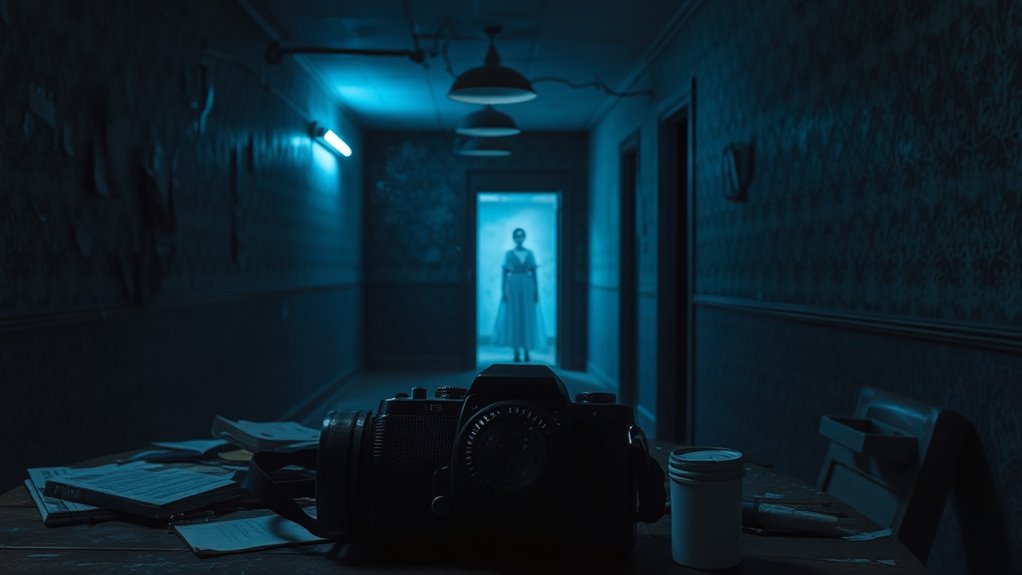Ghost hunting shows often hide the truth behind staged scenes, scripted reactions, and editing that exaggerates or fabricates paranormal activity. In reality, investigations are carefully planned routines with mundane tasks, equipment challenges, and environmental interferences that can lead to false positives. Skepticism helps separate genuine phenomena from manipulated footage designed to entertain. If you look closer, you’ll see how production choices shape the story, and there’s more behind the scenes you haven’t been shown.
Key Takeaways
- Ghost hunting TV shows often stage or script scenes for entertainment, not reflecting genuine spontaneous paranormal activity.
- Investigations involve careful setup, equipment calibration, and environmental awareness that TV shows frequently omit for drama.
- Editing techniques, quick cuts, and sound effects craft suspense, hiding the routine, methodical nature of real investigations.
- Environmental noise and technical limitations can cause false positives, but shows rarely discuss these common challenges.
- Skepticism and critical thinking reveal that many “evidence” clips are manipulated, staged, or misinterpreted to entertain viewers.
The Myth of Spontaneous Paranormal Activity

Many TV ghost hunting shows suggest that paranormal activity happens suddenly and without warning, but in reality, these events are often the result of careful setup or misinterpretation. Paranormal skepticism encourages you to question the spontaneity portrayed on screen and look for patterns or signs of an investigative routine. In genuine investigations, phenomena are rarely random; they’re usually the product of deliberate efforts like setting up equipment or manipulating environments. Recognizing investigative routines and the importance of methodical procedures reveals that what appears spontaneous may be carefully orchestrated. TV shows often omit this context to create excitement, but real ghost hunting involves methodical procedures. Recognizing this helps you see through the illusion of spontaneous hauntings. By understanding the methodical procedures, you can better differentiate between staged or misinterpreted incidents and authentic paranormal activity. This awareness underscores the significance of local knowledge in understanding the context of investigations and avoiding misconceptions.
The Reality of Nighttime Investigations

Nighttime investigations are often portrayed as the most intense and revealing moments in ghost hunting, but in reality, these sessions require careful planning and patience. You’ll rely heavily on lighting techniques to create a safe environment and to help spot subtle signs of activity. Low, strategic lighting helps maintain the eerie atmosphere while allowing your team to move quietly. Additionally, proper support hours can be essential to ensure access to necessary resources or assistance during investigations. Team dynamics are essential—everyone must communicate effectively, stay aware of each other’s positions, and work together smoothly to cover ground and interpret phenomena. Unlike TV shows, real investigations demand focus, coordination, and adaptability. There’s no rush for dramatic moments; success often depends on methodical observation, careful documentation, and patience, not just sensational footage. Effective communication strategies are vital for ensuring everyone remains informed and responsive throughout the investigation. Additionally, understanding emotional support can be crucial if team members encounter unsettling experiences. Incorporating proper safety protocols ensures that everyone remains protected throughout the investigation, which is often overlooked in dramatized portrayals. Furthermore, recognizing the symbolism present in unexplained phenomena can assist in correctly interpreting potential signs of activity.
The Equipment and Technical Challenges

When you rely on equipment during investigations, you often face limitations and the risk of failures that can compromise your results. Environmental interference, like electromagnetic noise or weather conditions, also makes capturing clear evidence difficult. These technical challenges highlight just how tricky it is to get reliable data in real-world ghost hunts. Additionally, AI security concerns emphasize the importance of developing robust safety measures for technological tools used in investigations. For instance, regulatory standards for noise levels and environmental impact can influence the deployment and design of investigative equipment. For example, Volkswagen Tuning technologies such as ECU remapping and sensor enhancements can improve device accuracy but also introduce new vulnerabilities to hacking or interference.
Equipment Limitations and Failures
Despite advancements in ghost-hunting equipment, technical limitations often hinder the accuracy and reliability of investigations. Camera malfunctions and battery failures can abruptly end sessions or give false readings. Equipment isn’t foolproof, and relying solely on devices can lead to missed or misinterpreted phenomena. Here’s a quick look at common issues:
| Issue | Impact | Cause |
|---|---|---|
| Camera Malfunctions | Missed visual evidence | Hardware faults, poor connection |
| Battery Failures | Loss of power mid-investigation | Voltage drain, cold temperatures |
| Sensor Failures | Inaccurate readings | Calibration errors |
| Recording Glitches | Data loss or distortion | Software bugs |
| Device Overload | False positives or errors | Environmental interference |
Furthermore, data analytics is essential for understanding and interpreting the data collected, yet it can be compromised by device errors or environmental factors. proper calibration of equipment is crucial to obtaining accurate results and minimizing errors during investigations. In addition, regular maintenance can help prevent many of these issues before they occur.
Environmental Interference Challenges
Environmental interference often complicates ghost-hunting investigations by introducing unpredictable signals and noise. Sound pollution from nearby traffic, machinery, or wind can mimic or mask ghostly sounds, making it difficult to distinguish genuine phenomena. Ambient noise from everyday activity creates a constant background that hampers audio recordings and EVP captures. These disruptions force you to sift through layers of interference, often leading to false positives or missed evidence. Technical equipment struggles to filter out such noise, which can overwhelm sensitive devices like EVP recorders and thermal cameras. As a result, you need to be vigilant about environmental factors and prepared to adapt your methods to minimize interference, ensuring your findings are as reliable and accurate as possible.
The Role of Skepticism and Critical Thinking

Skepticism and critical thinking are essential tools when evaluating ghost hunting shows, which often blur the line between entertainment and reality. You need to approach these programs with a healthy dose of paranormal skepticism, questioning the evidence presented rather than accepting it at face value. Critical thinking helps you analyze the methods used to capture supposed paranormal activity and spot logical inconsistencies or suggestive editing. Remember, many scenes are crafted for entertainment, not scientific accuracy. By applying skepticism, you guard against being misled by false or exaggerated claims. Question the motives behind the evidence and consider alternative explanations. This mindset allows you to separate genuine curiosity from sensationalism, helping you form a more balanced understanding of what’s real versus what’s staged for TV.
The Behind-the-Scenes Preparation and Routine Tasks

Behind-the-scenes preparation and routine tasks are the backbone of ghost hunting shows, often shaping what viewers see on camera. You’ll find that effective team coordination is essential, ensuring everyone knows their roles and stays safe during investigations. Before filming, teams spend hours on location scouting, researching sites to identify potential hotspots and plan their approach. They organize equipment, double-check batteries, and set up cameras and audio gear to capture any activity. These tasks may seem routine, but they’re critical for a smooth investigation. Coordinating schedules and responsibilities helps prevent chaos and keeps the team focused. While viewers see the dramatic moments, behind the scenes, meticulous planning and preparation lay the foundation for every eerie encounter.
The Impact of Production and Editing on the Storytelling

Production choices like selective footage and dramatic music shape how you experience the story, often emphasizing certain moments over others. These edits can create a sense of suspense or fear that may not fully reflect reality. Understanding how scripting and editing influence the narrative helps you critically evaluate what’s truly genuine.
Selective Footage Choices
Selective footage choices greatly influence how ghost hunting stories are told on television. Producers select specific clips, camera angles, and moments to craft a compelling narrative, often emphasizing suspense. Casting decisions also shape the story, highlighting certain individuals’ reactions over others. This editing can create a skewed perception of events, making encounters seem more convincing than they are. For example, close-up camera angles might exaggerate fear, while strategic cuts hide mundane moments. The table below illustrates how these choices impact storytelling:
| Aspect | Effect | Purpose |
|---|---|---|
| Camera angles | Enhance suspense or confusion | Manipulate viewer emotions |
| Casting decisions | Focus on dramatic reactions | Drive story engagement |
| Footage selection | Highlight key moments, omit others | Control narrative flow |
| Editing speed | Increase tension | Keep viewers engaged |
| Sound cues | Amplify perceived intensity | Heighten suspense |
Dramatic Music Effects
Dramatic music plays a vital role in shaping how ghost hunting stories unfold on television. It amplifies tension, making every whisper or bang seem more sinister. This manipulation often plays into ghostly clichés and paranormal stereotypes, shaping your perception of what’s real. You might find yourself convinced that every unexplained noise is proof of spirits. To deepen this effect, producers use:
- Sudden music cues to create jump scares
- Low, rumbling tones to evoke fear
- Crescendos during supposed sightings
- Silence followed by sudden loud sounds for shock value
These techniques distract from the actual reality, emphasizing entertainment over authenticity, and subtly guiding your emotional response. It’s not just about the story; it’s about how the story is scored to fit a narrative.
Scripted Narrative Influence
While the footage you see on ghost hunting shows may seem spontaneous, much of it is carefully crafted through editing and scripting choices. Producers often shape the narrative to heighten suspense or reinforce paranormal myths, even when the activity appears spontaneous. This manipulation influences your perception of ghost encounters, making them seem more convincing than they are. The following table highlights how scripted storytelling impacts your understanding:
| Spontaneous Activity | Editing Techniques | Viewer Perception |
|---|---|---|
| Faked or staged moments | Quick cuts and sound effects | Belief in paranormal myths |
| Recreated scenes | Selective footage | Overestimation of real activity |
| Scripted reactions | Music and visual cues | Increased fear and excitement |
| Hidden manipulations | Narrative framing | Confusion about authenticity |
Understanding this influence helps you see through the illusion of spontaneity, revealing how storytelling shapes your beliefs.
Frequently Asked Questions
How Do Producers Select Locations for Ghost Hunting Shows?
When selecting locations for ghost hunting shows, producers focus on intriguing stories and potential for paranormal activity. They consider location selection carefully to guarantee safety and viewer engagement. Filming challenges like access, permits, and environmental conditions also influence choices. You’ll notice that producers often prioritize places with rich histories, but they also weigh logistical factors to create compelling content while managing the complexities of filming in these spooky locations.
Are Investigators Paid or Volunteers?
You might wonder if investigators are paid or volunteers. During the recruitment process, producers often select volunteers who undergo investigator training to guarantee they’re prepared. Paid investigators are less common but may be involved in professional ghost hunting teams. Most participants, however, volunteer their time, motivated by curiosity or passion. This setup helps maintain authenticity, but it also means that some aspects of the investigation are driven by personal interest rather than compensation.
What Safety Measures Are in Place During Investigations?
You prioritize safety during investigations by implementing strict protocols, checking equipment regularly, and maintaining clear communication. You stay prepared for equipment malfunctions, guaranteeing backup gear is available, and you keep crew safety at the forefront with safety gear, emergency plans, and trained team members. These measures help prevent accidents, protect everyone involved, and ensure the investigation runs smoothly, regardless of unexpected issues that may arise.
How Much of the Show Is Scripted Versus Genuine?
You might wonder how much of the show is scripted versus genuine. Often, dramatization embellishment and camera tricks are used to enhance the story and keep viewers engaged. While some moments are real, producers sometimes stage or exaggerate events for entertainment. So, don’t assume everything is completely authentic—many scenes are carefully crafted, blending truth with entertainment to create a compelling ghost-hunting experience.
Do Investigators Experience Personal Paranormal Encounters?
You might wonder if investigators experience personal paranormal encounters. While some do report such experiences, paranormal skepticism often influences their perceptions, and investigator biases can shape how they interpret encounters. Many professionals try to remain objective, but personal experiences vary widely. Remember, what you see on TV isn’t always the full story—some encounters are genuine, while others are influenced by expectations, biases, or the desire for compelling footage.
Conclusion
As you watch ghost hunting shows, remember that over 80% of claimed paranormal activity is staged or misinterpreted. Behind the scenes, producers often edit footage to create a more compelling story, while investigators juggle technical challenges and skepticism. The next time you’re captivated by supernatural claims, consider the complex reality behind the scenes—where science, routine, and storytelling often blur, revealing a far less glamorous truth about what really goes into these investigations.









